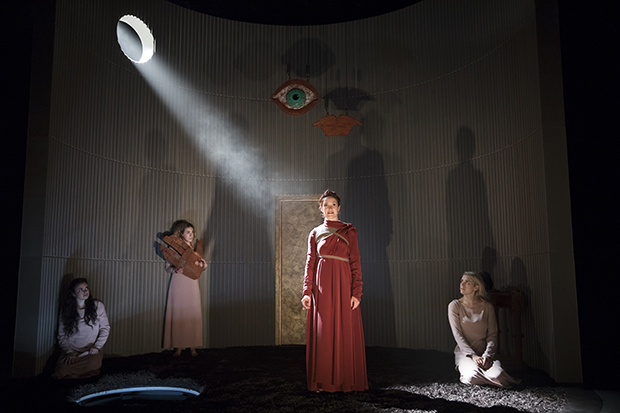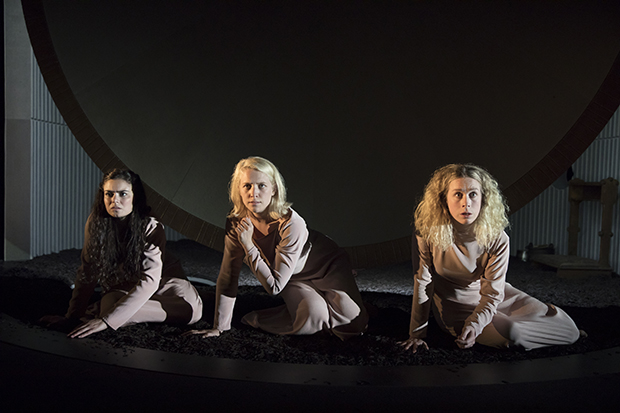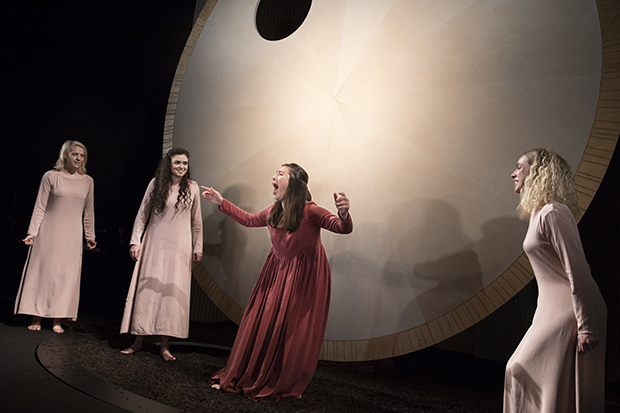In the Green: Can Two Nuns Share a Cell for 30 Years Without Driving Each Other Crazy?

(© Julieta Cervantes)
You can give the church one-tenth of your income as a "tithe," but can you also give the church one-tenth of your children? According to Grace McLean, author and star of the new musical In the Green, the parents of Hildegard von Bingen did just that when they committed their 10th child to a lifetime of monastic life with Jutta von Sponheim, the anchoress of the Benedictine monastery of Disibodenberg. In this unusual world premiere from LCT3, we get to see what their life was like in Jutta's cell, a dirt-floor room that they shared for three decades without ever leaving — The Odd Couple it's not.
Beyond the faint comic relief of the eccentric monk Volmar (Rachael Duddy), there's nothing funny about this story. At the age of 8, Hildegard (portrayed in the first scene by a creepy puppet fashioned by Amanda Villalobos) is entombed with Jutta (McLean). As an anchoress, Jutta has been read her last rites and has committed to living the remainder of her life as a dead person (with Hildegard as her dead companion). They receive life-sustaining food and water through a small window, but little else. With nothing but time on her hands, Jutta prays and orders Hildegard to dig her own grave. "Life is better in death," she sings, a refrain only slightly less jaunty than "Oh, what a beautiful mornin'." This trapped-in-the-closet routine lasts for 30 years (80 minutes in our time) and would make a decent Stephen King thriller…but it's a musical instead.
And what an extraordinary musical it is. Within the cell, Hildegard is played by three actors: Rachael Duddy is her attentive eye, Hannah Whitney her busy hand, and Ashley Pérez Flanagan her hungry mouth. The three performers become one being, their voices blending seamlessly to incant some incredibly difficult music, all of which sounds flawless under the direction of music supervisor Kris Kukul and music director Ada Westfall.
McLean's score references both the clear, straight vocal tones of the Middle Ages (Hildegard was, among other things, a composer) and the repetitive staccato of Philip Glass, with plenty of indie rock in between. Much of the accompaniment comes from McLean herself, who starts a beat by vocalizing into a microphone (cleverly disguised as a rosary). That snippet of sound is then looped to form the foundation of a song. McLean is a force of nature whose natural intensity both propels the score forward and captures the severity of Jutta. Her songs are guttural, heavenly, and totally unlike anything else playing in New York right now.
Director Lee Sunday Evans showcases that uncommon score while also doing a decent job of presenting a story that drags and drags until it experiences a burst of plot in the final scenes. That's when Hildegard, after decades of sequestration, politely declines to re-up as an anchoress. Instead, she becomes a vigorous political force in Christendom. This is the aspect of Hildegard's life that is best known, and perhaps that is why McLean is least interested in it.

(© Julieta Cervantes)
Certainly, Kristen Robinson's set betrays which part of Hildegard's life is the heart of this story. The stage is dominated by a massive central cylinder depicting Jutta's cell that appears to be modeled after the Hildegardis Kapelle built near the ruins of Disibodenberg. It feels modern and all too airy for a medieval anchoress's cell. Bizarrely, Jutta spends much of the show knelling on an upholstered prie-dieu, an outrageous luxury that wouldn't have even been afforded to wealthy parishioners in the 12th century — much less a half-starved mystic.
Oana Botez's modest and worn costumes do a better job of conveying the earthiness of medieval Germany, although Hildegard's sparkly final costume verges on high camp (as Catholic vestments often do). Barbara Samuels's lighting is the most appealing aspect of the design, providing a visual manifestation of Hildegard's crusade to find light in the darkness.
But neither gorgeous lighting nor virtuosic performances mitigate the fact that this story is a total downer and the sound of the score becomes tedious by the end. In the Green is a must-see for serious connoisseurs of musical theater, but it's a heavy lift for casual fans in the summertime.

(© Julieta Cervantes)
Still, it's hard not to admire McLean's ambition to expand what the American musical can do and say, especially with her abrupt and unsettling conclusion. The easier road would have been to portray Hildegard as an unambiguous shero, a badass woman shining a light through the Dark Ages. Admirably, McLean takes the road less traveled, depicting the elderly Hildegard as a glittering tchotchke of Catholicism who has spent a little too much time cloistered with the other Hummel figurines to really comprehend the noxious byproducts of her teachings. McLean leaves us with the lasting impression of a woman who was driven by a divine mission, and who accomplished both great and terrible things in her zeal. She's a precursor to fallen feminist icons like Linda Fairstein and Aung San Suu Kyi. When everyone is looking for a hero, McLean bravely refuses to give us yet another false idol.










